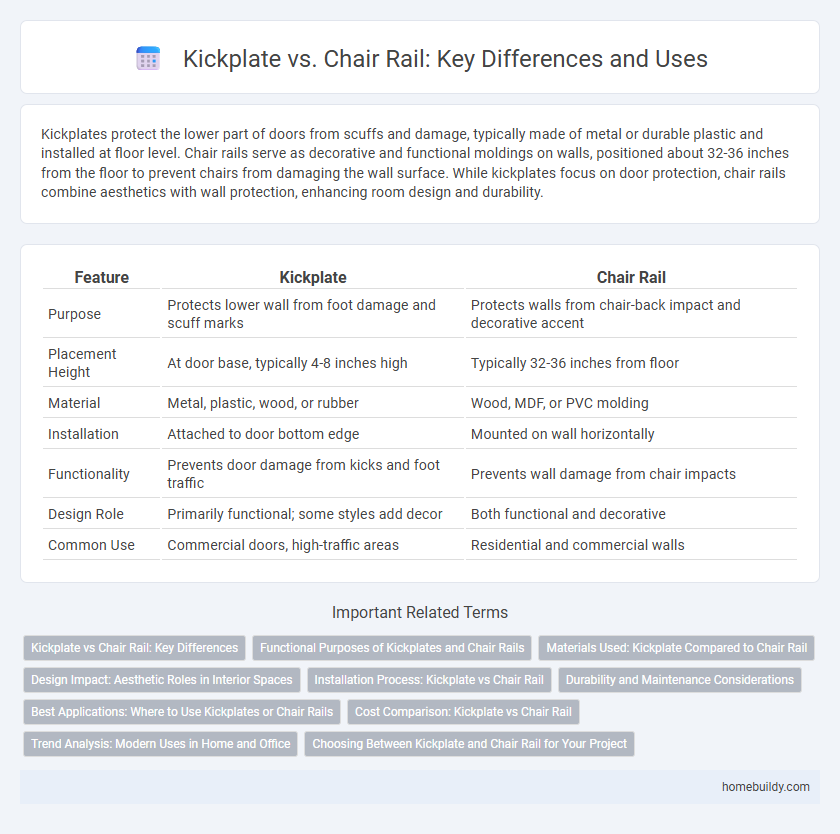Kickplates protect the lower part of doors from scuffs and damage, typically made of metal or durable plastic and installed at floor level. Chair rails serve as decorative and functional moldings on walls, positioned about 32-36 inches from the floor to prevent chairs from damaging the wall surface. While kickplates focus on door protection, chair rails combine aesthetics with wall protection, enhancing room design and durability.
Table of Comparison
| Feature | Kickplate | Chair Rail |
|---|---|---|
| Purpose | Protects lower wall from foot damage and scuff marks | Protects walls from chair-back impact and decorative accent |
| Placement Height | At door base, typically 4-8 inches high | Typically 32-36 inches from floor |
| Material | Metal, plastic, wood, or rubber | Wood, MDF, or PVC molding |
| Installation | Attached to door bottom edge | Mounted on wall horizontally |
| Functionality | Prevents door damage from kicks and foot traffic | Prevents wall damage from chair impacts |
| Design Role | Primarily functional; some styles add decor | Both functional and decorative |
| Common Use | Commercial doors, high-traffic areas | Residential and commercial walls |
Kickplate vs Chair Rail: Key Differences
Kickplates protect the lower portion of doors from scuffs and damage caused by foot traffic, while chair rails primarily serve as decorative molding that shields walls from chair backs. Materials for kickplates typically include metal, vinyl, or plastic to ensure durability, whereas chair rails are often made of wood or MDF for aesthetic appeal. Installation height varies, with kickplates mounted at the bottom of doors and chair rails positioned about 32-36 inches from the floor along walls.
Functional Purposes of Kickplates and Chair Rails
Kickplates protect doors from scuffs and damage caused by foot traffic, providing durable reinforcement where hands and feet frequently make contact. Chair rails safeguard walls by absorbing impacts from chairs, preventing dents and scratches in dining or workspace areas. Together, kickplates and chair rails enhance durability and maintain the aesthetic integrity of interiors by targeting specific wear points.
Materials Used: Kickplate Compared to Chair Rail
Kickplates are typically made from durable materials such as stainless steel, aluminum, or brass to withstand frequent impact and resist scratches, making them ideal for high-traffic areas. Chair rails, on the other hand, are often constructed from wood, MDF, or plastic, emphasizing aesthetic appeal and wall protection rather than heavy-duty durability. The material choice directly influences the kickplate's functional strength versus the chair rail's decorative and protective purpose.
Design Impact: Aesthetic Roles in Interior Spaces
Kickplates provide a sleek, functional design element protecting walls at foot level while maintaining minimal visual interruption, ideal for modern, streamlined interiors. Chair rails offer a more decorative, traditional aesthetic by dividing wall space horizontally and allowing for contrasting paint or paneling treatments, enhancing visual interest and architectural depth. Choosing between kickplates and chair rails depends on desired interior style and the balance between practical wall protection and decorative appeal.
Installation Process: Kickplate vs Chair Rail
Kickplate installation typically involves simple surface mounting at the base of doors or walls, requiring minimal tools and time, while chair rail installation demands precise measurement, wall preparation, and secure attachment at mid-wall height to protect against furniture damage. Kickplates often use adhesive backing or screws for quick application, whereas chair rails may necessitate cutting, mitering corners, and anchoring with nails or screws for a durable finish. The straightforward installation of kickplates makes them a preferred choice for quick protection, whereas chair rails offer a more decorative solution but with increased labor and complexity.
Durability and Maintenance Considerations
Kickplates, typically made from metal or heavy-duty plastic, offer superior durability compared to wooden chair rails, resisting dents, scratches, and moisture damage more effectively. Maintenance of kickplates requires minimal effort, often needing just a simple wipe-down to retain their appearance, whereas chair rails may demand periodic repainting or refinishing to address wear and potential water damage. The robust material composition of kickplates makes them an ideal choice for high-traffic areas where long-term protection and low upkeep are priorities.
Best Applications: Where to Use Kickplates or Chair Rails
Kickplates are best suited for high-traffic areas where doors face frequent impact and scuffing, such as commercial buildings, healthcare facilities, and schools, providing durable protection and easy maintenance. Chair rails are ideal for interior walls in dining rooms, hallways, and offices, preventing damage from furniture while adding decorative appeal. Choosing between kickplates and chair rails depends on the specific location and type of impact protection needed, with kickplates primarily protecting doors and chair rails safeguarding walls.
Cost Comparison: Kickplate vs Chair Rail
Kickplates generally offer a more cost-effective solution compared to chair rails, primarily due to lower material and installation expenses. While chair rails require precise wall mounting and often professional labor, kickplates can be installed with minimal tools and time, reducing overall project costs. Choosing kickplates can significantly decrease maintenance and replacement expenses, making them a budget-friendly option for protecting walls in high-traffic areas.
Trend Analysis: Modern Uses in Home and Office
Kickplates and chair rails both protect walls but serve different aesthetic and functional roles in modern interiors. Kickplates, often made from metal or durable plastics, are favored in contemporary office designs for their sleek, minimalist look and high durability against scuffs. Chair rails remain popular in residential settings for adding decorative detail and visual separation, blending traditional charm with modern color palettes for trending home decor.
Choosing Between Kickplate and Chair Rail for Your Project
Choosing between a kickplate and a chair rail depends on the functional and aesthetic needs of your space. Kickplates, typically installed on doors, protect surfaces from scuffs and damage caused by foot traffic, while chair rails are mounted on walls to prevent chair back damage and add decorative appeal. Consider durability, placement, and design goals to determine whether a kickplate or chair rail best suits your project's requirements.
kickplate vs chair rail Infographic

 homebuildy.com
homebuildy.com